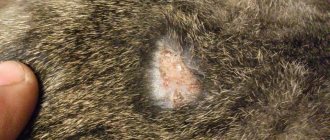The most common ectoparasites that terrorize domestic animals are ticks and fleas. But there are other dangerous insects that deserve the attention of owners. These include the family of lice eaters, which cause helminthiasis and various infections in cats. Despite the fact that the parasites themselves are quite harmless, the infections they carry can cause the death of an infected pet.
What are lice eaters in cats?
The lice-eater family includes lice - tiny translucent insects that resemble yellowish or gray grains of rice. The length of an adult individual is no more than 2 mm, so it is very difficult to detect with the naked eye.
Features of the disease and photos of lice eaters in cats
Parasites differ from ordinary lice, their closest relatives, by the absence of wings. They are held on the animal's body with the help of strong claws and hook-shaped jaws.
Their main food is keratinocytes, that is, cells of the epidermis and hairs. The vital activity of the pest causes trichodectosis in cats, a disease accompanied by severe itching.
Parasites are very prolific. One female leaves behind up to 100 eggs, attaching them to the root of the hair with mucus. The entire development cycle takes about 28 days, so under favorable conditions the number of individuals increases rapidly.
Difference from flea and lichen infestation
Symptoms and methods of treating lice in cats are similar to infestation with fleas and scabies mites, as well as ringworm. Despite this, all these parasites and fungus are very different from each other.
Unlike scabies mites, lice mites are not able to penetrate the skin. They parasitize strictly on the surface of the epidermis.
The mouthparts of the lice eater are of the “gnawing” type. It is not suitable for sucking blood, so plasma feeding is possible only if the skin is severely damaged as a result of scratching. In addition to its feeding method, its appearance also distinguishes it from fleas. The head width of lice-eating lice is larger, and their body tapers towards the base.
Also worth mentioning to the owner. If fleas, saturated with blood, often move to other animals, then lice-eaters prefer not to change their location for quite a long time.
Routes of infection
The main route of infection is direct contact with an infected person. Parasites can move to another body during joint games, during sexual contact or a fight. Lice eaters in kittens usually appear from a sick mother, since they rarely communicate with other relatives.
Transmission of trichodectosis pathogens through objects (dirty shoes, bedding, slicker) or carriers (rats and mice) is much less common. The risk group includes animals kept in crowded conditions. For this reason, most of the infected are residents of cat shelters.
In addition to unfavorable living conditions, infection is facilitated by low immunity due to the following factors:
- the presence of immunodeficiency, including FIV;
- high humidity, which increases the incidence of pulmonary diseases;
- young or old age;
- malnutrition;
- lack of hygiene.
Seasonality is also observed. Most often, outbreaks of the disease occur in winter and autumn.
Tapeworms
What types of cat tapeworms are there? Among the tapeworms in the body of cats, the cucumber tapeworm, which can reach a length of 30 cm, feels good.
Such worms in cats are easily transmitted to humans, in whose body they can grow up to 1.5 meters. The worm is localized in the intestinal area, clinging to its walls with hooks, thereby severely damaging the mucous membrane. The helminth is spread by fleas and lice-eaters, which enter the pet’s oral cavity during hygiene procedures.
The main symptoms of this pathology are:
- severe weight loss;
- irritability of the animal;
- the appearance of pain in the abdominal cavity;
- rumbling in the stomach;
- vomiting and chronic diarrhea;
- loss of sleep;
- apathy.
The wide tapeworm in the body of cats can grow up to one and a half meters in length. And when the host is infected, it can reach 12 meters. A pet becomes infected with broad tapeworm by eating raw river fish or accidentally consuming river crustaceans. You can determine the infection by observing your pet. The parasitic symptoms are completely similar to those of cucumber tapeworm.
Cestodes are small helminths that develop up to 5 mm in length. The body of cestodes is equipped with chitinous hooks or suction cups, with the help of which the parasite is attached to the host body. The flat body with a head is divided into several parts, each of which contains parasitic eggs. The worm is localized in the intestinal region, where it gets if the animal eats small rodents - for example, mice, rats or hamsters.
Such worms in cats are primarily dangerous for the owner, while the pet can feel great carrying these worms inside for years.
Flukes are flatworms that can destroy the structure of internal organs and disrupt their functions. The length of these worms can reach 1.5 meters. Such parasites multiply very quickly. The fluke can carry out its life activities in various organs, attaching itself to their walls using suction cups equipped with several rows of teeth.
They mainly settle in the liver, lungs, intestines, and also in the bladder. In some cases, the fluke may be localized in non-standard organs - for example, in the eustachian tube or conjunctival sac. This type of helminth enters the cat's body along with poorly prepared freshwater fish and crustaceans.
Often the fluke affects the liver, gradually eating away its tissue. This type of helminth is called liver. Small worms like to localize themselves in the pancreas or gall bladder. Typical symptoms include:
- decreased appetite or complete loss of appetite;
- pain in the abdominal area;
- development of muscle weakness, the pet may sometimes fall as if its legs could not support it;
- vomiting and diarrhea, the masses turn yellow;
- elevated temperature.
Advanced pathology can only be managed with long-term and complex treatment.
These worms do not grow even to 1 cm in length, but they provoke the development of cysts in the lung area. During their vigorous activity, lung tissue is destroyed. Symptoms:
- the temperature rises;
- the appearance of a severe cough;
- the cat develops a fever;
- the pet begins to “sob with its chest”;
- appetite decreases.
Almost all types of cat worms are actively transmitted to humans, so they should be treated promptly. To avoid infection or illness of the pet, the owner must deworm the cat every six months. When feeding an animal prepared food, it should be subjected to thorough heat treatment. Sometimes it is necessary to disinfect the pet's sleeping place and tray, as well as remove fleas from the animal's fur.
What lice eaters look like in cats: symptoms
Despite their small size, the presence of lice eaters is quite easy to detect. As a result of their vital activity, they cause the following symptoms in the animal:
- loss of appetite, lethargy, irritability and sleep disturbances;
- severe itching, accompanied by constant scratching and biting until bleeding wounds form;
- peeling of the skin, which stimulates the appearance of dandruff and worsens the appearance of the coat;
- partial baldness on the head, tail, ears and thighs with the appearance of red, inflamed bald spots on thinning areas.
It is quite simple to distinguish trichodectosis from lichen or flea infestation without laboratory diagnostics. Despite this, you should not engage in treatment until a diagnosis is made. The invasion may be mixed.
There is also a risk of choosing the wrong dosage of medications, so do not neglect the opinion of the veterinarian, who takes into account the individual characteristics of each patient.
Why is trichodectosis dangerous?
Cat lice bites are less painful than those of other ectoparasites. The symptoms of infection in the early stages are mild, so owners often turn a blind eye to the changes that occur or try to fight the problem with folk remedies. As a result, the animal experiences the following complications:
- exacerbation of chronic diseases caused by decreased immunity;
- secondary infections caused by bacteria and fungi entering scratches;
- anemia and exhaustion of the body;
- allergic reactions resulting from the activity of pests;
- helminthiases that develop when worms are transmitted from an infected lice eater.
The likelihood of developing helminthic infestation increases when its causative agent is ingested. It is almost impossible to avoid this, since the infected animal constantly bites the itchy areas.
What parasites can humans get infected from cats?
Many people naively believe that a pet is the cleanest animal, and that’s the only reason it won’t infect its owner with anything. Of course this is not true. There are two ways in which an animal can “transmit” parasites.
The first involves fur, as well as the tongue. In the second there is a tray and things that the infected animal touches. External parasites are not dangerous.
A cat can infect its owner with helminths. For example, roundworms are dangerous, like all nematodes. Ascariasis is fraught with the fact that parasites accumulate in the respiratory tract, allergies become severe, vitamin deficiency and granulomas occur. Tapeworms pose a serious danger to young children, and echinococci can be fatal.
Note! Toxoplasmosis is a serious disease that a cat can infect through its feces if it itself is sick. If a pregnant woman contracts toxoplasmosis, the child may develop developmental abnormalities.
Diagnostics: at home and in the veterinary clinic
To make a diagnosis at home, you need to place the cat under a lamp or natural light source for 8-10 minutes. Heat-loving parasites will definitely come to the surface of the fur to warm themselves. They can be seen under a magnifying glass, and the remains of their vital activity - larger black dots - are visible even with the naked eye. The rest of the time, pests are inactive, so it is the reaction to light that will help distinguish them from fleas.
If the home test result is positive, be sure to schedule an examination at the veterinary clinic. Using a skin scraping, the doctor will determine the degree of infection and select a safe medicine for your pet.
In case of advanced infestation, drugs against lice will have to be supplemented with other medications aimed at suppressing secondary infection and boosting immunity.
Treatment methods
Taking antibiotics and antimycotic drugs is practiced only in the presence of a bacterial or fungal infection. With a mild form of trichodectosis, it is enough to limit yourself to insecticides. Please note that these drugs are very toxic. Do not use them unless prescribed.
Drops, sprays and other medications
Anti-hairworm remedy for cats is available in several forms. These include:
- drops on the withers (Hartz, Fiprex, Barrier);
- sprays (Acaromectin, Stronghold, Frontline);
- emulsions (Merial, Deltsid, Bionics);
- shampoos (Bars, Greenfort, Bolfo).
The last form is the safest, as it is almost immediately washed off from the surface of the body. For the same reason, it is inferior in efficiency. Its use is justified only at the initial stage of infection.
Insecticides are applied at least twice as they are not designed to kill unhatched larvae. This method of application makes it possible to destroy grown individuals before they become sexually mature and capable of laying new eggs.
Due to toxicity, the drugs are recommended to be applied to areas inaccessible to the pet’s tongue: this is the line along the spinal column and withers. The validity of medications is no more than 3 months, so after the destruction of parasites, they are recommended to be used for preventive purposes.
Folk remedies
At home, treatment for lice in cats may include the use of herbal infusions. To prepare them you need the following ingredients:
- Three tablespoons of string and 500 ml of water. Simmer the mixture for 10 minutes, cool and strain to remove any solids.
- Two and a half teaspoons of chamomile flowers and 200 ml of water. Bring the mixture to a boil and simmer for 4 minutes. Leave the resulting broth for 30 minutes in a warm place and strain it through cheesecloth.
- One tablespoon of celandine and 200 ml of water. Keep the mixture in a water bath for 15 minutes and let it sit warm for another 1 hour. After the specified time, strain the broth and cool.
It is recommended to bathe a sick animal in the broth every day until the symptoms disappear. The liquid should be at room temperature, so do not store it in the refrigerator or reheat it before use.
This treatment method is suitable for pets with sensitive skin and kittens. The essential oils contained in the listed herbs inhibit the vital activity of insects and force them to leave the animal's body.
Please note that such procedures are only effective for mild forms of the disease. It is also worth getting a preliminary consultation with a veterinarian and making sure that the grass does not cause allergies in your pet.
Care and hygiene
A pet with trichodectosis will need a special collar (also known as an Elizabethan collar). It will prevent the drug from being licked until completely absorbed.
In addition to regular treatment with one of the previously listed drugs, it is necessary:
- carry out wet cleaning of the room using Ecocide, Neostomozan or Ectomin;
- steam treat the infected pet’s personal belongings (toys, bed, scratching post);
- prevent wounds from licking and promptly treat them with an antiseptic to prevent the penetration of bacteria;
- worm the cat immediately after recovery.
In case of extensive skin damage, it is recommended to apply a sterile bandage to the wound. It will have to be changed after each treatment.
Dietary food for sick animals is not provided. Despite this, the diet should contain sufficient amounts of vitamins and minerals. You should consult your veterinarian about taking additional supplements.
Types of skin diseases caused by subcutaneous mites
What is the reason for such a sharp moral reaction to animal skin diseases? – These clichés come from childhood: “Don’t touch the cat, it has fleas, it’s dirty, contagious...”. Most people live by stereotypes, not even realizing how close “dirt and infection” are to themselves and there is only a small part of animal skin diseases that are transmitted to humans.
This is interesting! The most widespread and popular subcutaneous mite on the entire planet, Demodex folliculorum, is an opportunistic parasite.
Why conditional? – It’s very simple - demodex lives in the skin of all people and mammals, but attacks only when there are means for this - the immune system is weakened, the skin is irritated, etc. Before you run to the bath and wash yourself with a brush, read the next paragraph!
Demodex is not an enemy or a mite, it is a microscopic organism similar to a worm that lives in the hair follicle of any healthy person and animal, especially if the carrier has an oily skin type. The subcutaneous mite looks, to put it mildly, disgusting, but it cannot be detected without a microscope, although the parasite can travel along the surface of the skin - very slowly and only at night. The photo shows an adult demodex specimen.
The parasitic friend feeds on excess sebum, which makes the animal healthier, but turns into an enemy if its food becomes “poor quality.” If there is a metabolic disorder, demodex begins to release toxic waste and dies after 15–25 days; the process of decomposition of the microorganism begins in the skin, which provokes itching, sensitivity and redness.
Demodex folliculorum is the causative agent of demodicosis, a rare and atypical disease for cats, the existence of which is questioned in principle. Dogs and people (facial mites) are more susceptible to the disease; among cats, young fragile individuals, animals that have suffered severe stress, or suffering from chronic pathologies or metabolic disorders can be affected. There are no natural predispositions or risk groups. Demodicosis is characterized by the following symptoms:
- Irritation, redness of the skin.
- Itching, scratching.
- Baldness, which begins in areas of the skin covered with short hair - the muzzle, the area behind the ears, armpits, paws, and abdomen. If the animal is not treated, it will become completely bald.
Probability of infection
A sick pet should be isolated. Lice beetles can spread to humans and other pets, so limit contact with your pet until it recovers.
Of people
Despite the possibility of infection, lice are not able to live on the human body. Too little fur causes their death from hypothermia within 2-3 hours. But even during this time, parasite bites can result in infection with worms, infection or an allergic reaction.
Children are at risk, so do not let them handle the animal's skin for you. When applying medications, use protective gloves and be sure to wash your hands with soap and water after each contact.
Other pets
The most serious threat an infected person poses is to other four-legged inhabitants. But even here, lice eaters are quite selective. The types of insects that parasitize dogs and cats differ from each other.
Cat pests that fall on a dog will deal with it in the same way as a person. They will not stay on his body for long, but they can infect him with other diseases if he accidentally bites him. Active reproduction is possible only on one more cat, so owners of several mustachioed pets should be as careful as possible.
Prevention of worms
Preventive deworming in kittens and cats should be carried out at least four times a year. And for pets walking outside, the schedule can be tightened. Compliance with hygiene and cleanliness standards. Several rules for preventing worms in cats:
- Something as simple as washing your hands after handling animals is a good way to prevent accidental infection.
- Also, do not allow your cat to lick its face and especially its lips. This also applies to kissing your pet on the nose.
- The cat's litter box should be changed frequently. It won't hurt to wash and disinfect it from time to time either.
- Do not give your cat raw foods, especially meat and fish!
- If there are several cats in the house, deworming medications will need to be given to everyone, and this should be done at the same time.
Compliance with simple prevention methods greatly reduces the risk of infection of a cat and, as a result, a person.
If you still have questions about the treatment of worms in cats, write in the comments, we will try to answer!











